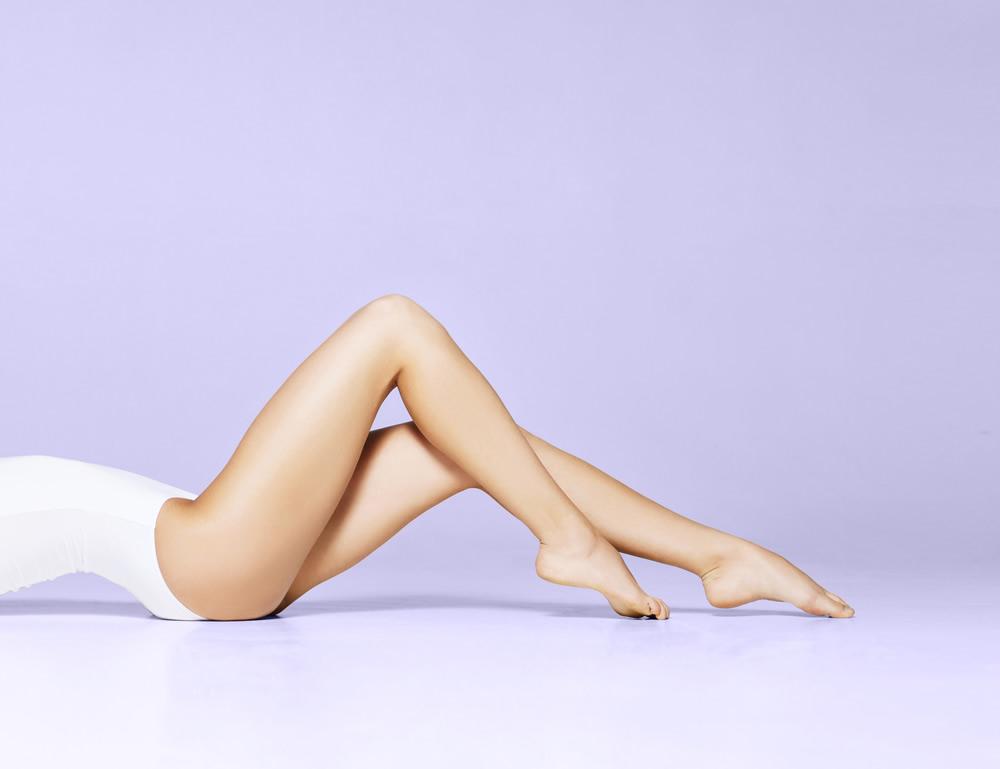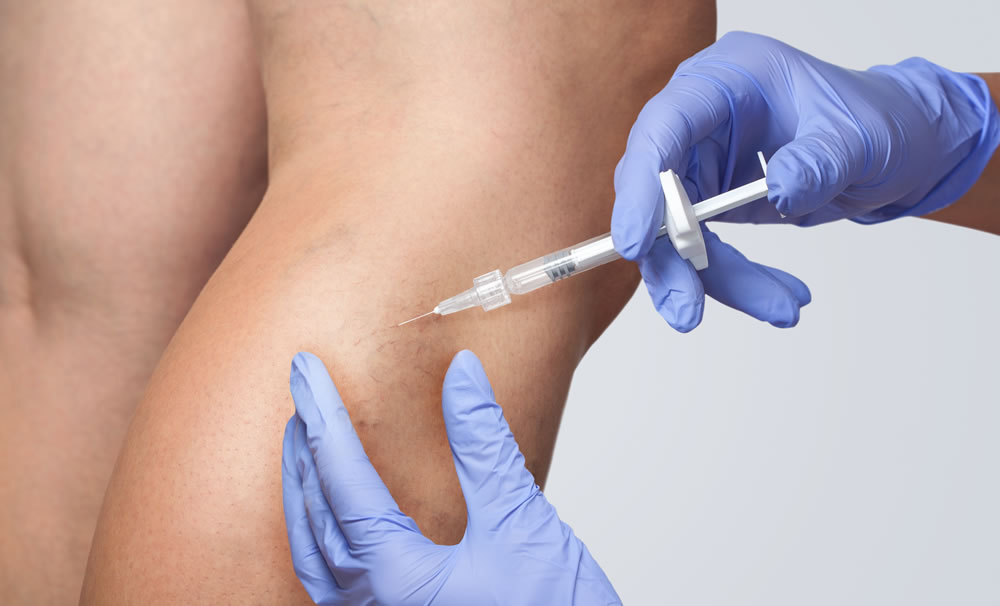Sclerotherapy: Leg Veins & Spider Veins
Sclerotherapy is a minimally invasive treatment option considered the gold standard for eliminating spider veins and varicose veins. Age, genetics, hormones, and lifestyle factors can all contribute to the development of these veins. Damaged blood vessels are characterized by red or blue skin discoloration and may make the legs feel heavy or tired. Typically affecting the lower extremities, spider veins and varicose veins are usually benign, although many patients opt for treatment for cosmetic reasons. Sclerotherapy is an innovative injectable treatment that eliminates these blood vessels with minimal downtime and side effects. At her private dermatology office in New York City, Dr. Michele Green performs Sclerotherapy treatments daily to help her patients achieve clear, smooth, and beautiful legs.
The Sclerotherapy treatment involves injecting a sclerosing agent called Asclera into the blood vessels. Once injected, Asclera causes the vessels to collapse and seal. The body then absorbs the vessels, resulting in vein- free skin after several weeks. Common side effects of sclerotherapy may include swelling, bruising, or tenderness at the injection sites. Most patients will require several treatment sessions spaced about four weeks apart to achieve optimal cosmetic results. In addition to sclerotherapy for varicose and spider veins, Dr. Green may also use the V-Beam laser treatment for broken blood vessels and telangiectasia and reduce red pigmentation. If you struggle with the appearance of varicose or spider veins and are interested in sclerotherapy for skin rejuvenation, Dr. Green is here to assist you.
Dr. Michele Green is an internationally renowned board-certified dermatologist with over two and a half decades of experience providing some of the world’s most discerning individuals with top cosmetic treatment options, including Sclerotherapy and V- Beam laser treatment for spider veins and varicose veins. Dr. Green takes a holistic approach and embraces a less-is-more philosophy, customizing each patient’s skin rejuvenation treatment plan to address their specific concerns and aesthetic goals. She is consistently recognized as one of New York’s best dermatologists by Super Doctors, Castle Connolly, The New York Times, and New York Magazine for her dedication to her patients and expertise.
What are varicose veins and spider veins?
Varicose veins are a common skin condition that occurs when blood vessels are weak or damaged. If the valves in veins are weakened or damaged, blood can pool, causing the veins to enlarge and become distorted. Varicose veins typically appear swollen, twisted, and deep blue or purple and tend to affect the lower extremities. Some of the symptoms of varicose veins include throbbing, heaviness, leg aches, cramping (especially at night), swelling, and skin discoloration around the veins. These painful symptoms can be exacerbated if you are in one position for too long, such as standing or sitting for extended periods. Heaviness, aching, and swelling in the legs can also occur after walking a great deal.
Spider veins, also known as telangiectasia, are visible broken blood vessels on the skin’s surface. Spider veins are similar to varicose veins but smaller. Typically, spider veins appear blue or red and are closer to the skin’s surface. Spider veins are commonly found on the lower extremities but may also develop on the face. Both spider and varicose veins are prevalent, affecting nearly 20% of all adults, and both conditions become more prevalent with age. Spider and varicose veins are present in both men and women but are more common in women. These damaged veins may not necessarily require medical intervention, although they can sometimes cause some discomfort, and many patients choose to have them treated for cosmetic purposes.
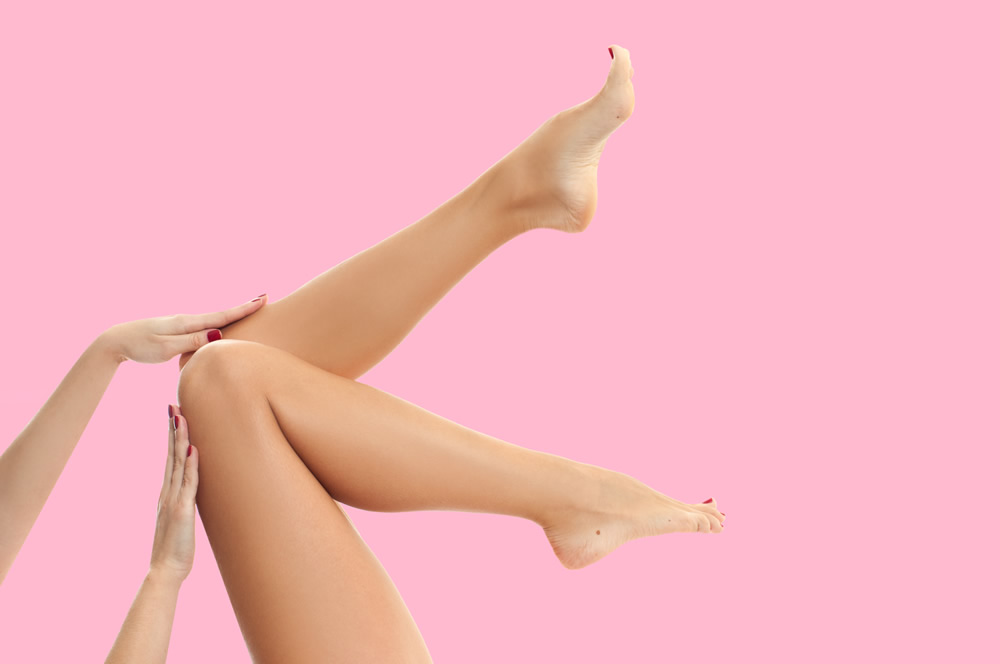
What causes varicose veins and spider veins?
Varicose veins stem from weakened or damaged blood vessels. Blood circulates throughout your body within two channels: arteries, which carry blood from your heart to the rest of your body, and veins, which return blood from your extremities back to your heart. Gravity helps the arteries deliver blood to the lower extremities. However, to pump blood back to your heart from your legs, your circulatory system must work against gravity. Valves in the veins prevent blood from flowing backward, but if they are weakened or damaged, blood can pool in the veins. This pooling causes the elastic walls of the veins to swell and twist, resulting in the appearance of varicose veins.
Risk factors for developing varicose veins and spider veins include:
Age —The risk of developing varicose or spider veins increases as one ages. Over time, the valves in the veins can become damaged due to the regular wear and tear of spending excessive time on one’s feet or remaining in the same position for long periods.
Hormone Fluctuations — Due to more frequent natural hormone fluctuations, women are more likely to develop varicose or spider veins than men. Certain hormones like estrogen and progesterone, which are more prevalent in female patients, can weaken or damage the walls of the blood vessels, leading to improper blood flow and pooling in the veins. The risk is even higher for women on hormonal birth control or those who become pregnant.
Genetic Predisposition — Researchers have found that individuals with a family member who has varicose veins are more likely to develop the condition themselves.
Obesity — Studies have shown that people who are overweight or obese have a greater risk of developing varicose veins or spider veins. Being overweight increases pressure on the veins in the lower extremities, which can damage blood vessel walls.
Sitting or Standing for a Long Time — Remaining in one position, such as sitting or standing for extended periods, is also a risk factor for developing varicose veins. Frequently standing for long durations can place significant pressure on the blood vessels in the lower extremities, leading to impairments in blood flow and circulation.
How does sclerotherapy work?
Sclerotherapy is a minimally invasive procedure used to reduce or eliminate spider veins and varicose veins. During the treatment, an experienced healthcare provider like Dr. Green employs a small needle to inject a sclerosant into the damaged veins of the legs. Dr. Green utilizes the sclerosing agent Asclera, which causes the veins to scar and collapse, allowing them to be reabsorbed into the body as local tissue. When this happens, blood flow is redirected through healthier veins. As the damaged blood vessels are absorbed, the appearance of spider or varicose veins on the skin’s surface fades. Additionally, the procedure can alleviate much of the discomfort associated with varicose veins, including swelling, cramping, and burning sensations. Through a series of Sclerotherapy treatments, patients can achieve clear, healthy-looking legs and enhance their self-confidence. During your initial consultation with Dr. Green, she will examine the treatment area to determine if you are a suitable candidate for sclerotherapy.
Who is a good candidate for sclerotherapy?
A suitable candidate for sclerotherapy is someone in good physical and mental health who wishes to eliminate varicose or spider veins for cosmetic or medical reasons. Many patients experiencing aching, swollen, burning, or nighttime cramps find relief through sclerotherapy. Candidates should not be pregnant or breastfeeding, as safety has not yet been established for these individuals. Patients may not be appropriate candidates for sclerotherapy treatment if they have a history of severe allergic reactions, blood clots, are active smokers, or are taking oral contraceptives. Sclerotherapy does not address venous insufficiency, so it is crucial to consult with a vascular surgeon if you suspect an underlying venous or arterial disease. When consulting with Dr. Green, she will review your medical and family history and conduct a physical assessment of your legs to determine if you are a suitable candidate for sclerotherapy treatment.
How to prepare for your Sclerotherapy treatment
Before Before Sclerotherapy treatment, it’s advisable to avoid blood thinners, such as aspirin, Aleve, Motrin (ibuprofen), and other anti-inflammatory medications, vitamins, and herbal supplements for at least one week prior to your Sclerotherapy treatment. This measure will help prevent and minimize bruising following sclerotherapy. Some patients may require pre-treatment with an oral antibiotic, which should be discussed during your consultation with Dr. Green. It is recommended not to apply any lotions or creams to the treatment area immediately before or after your Sclerotherapy injections. Avoid waxing or shaving the treated areas within 24 hours prior to your procedure. When you consult with Dr. Green regarding sclerotherapy treatment for varicose and spider veins, she will provide you with all the relevant information needed to ensure that you achieve the best results.
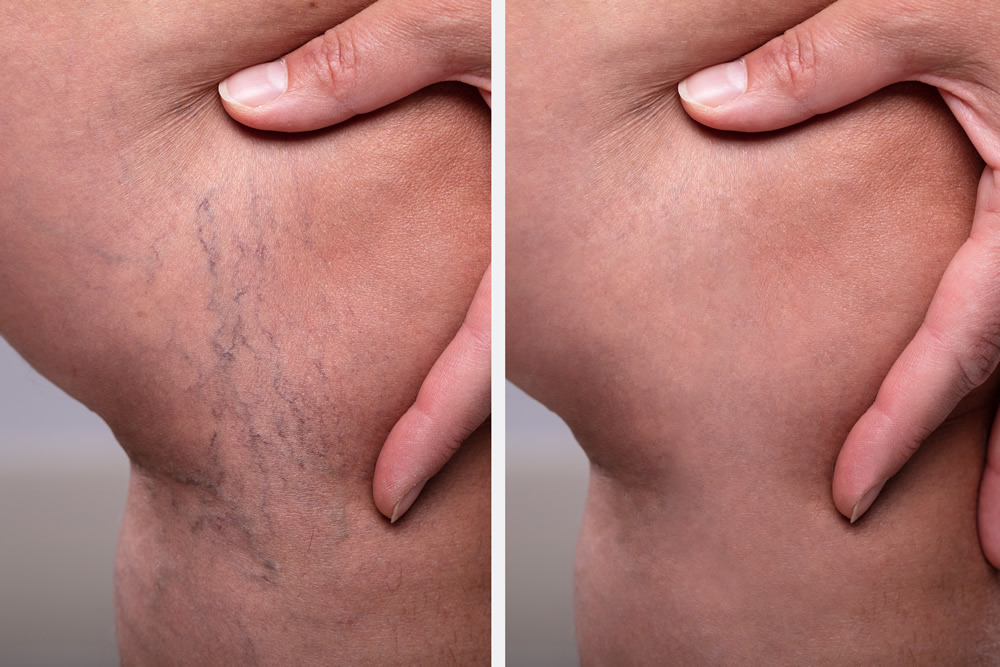
What to expect during Sclerotherapy treatment
On the day of your sclerotherapy appointment, a topical anesthetic should be applied to the skin for one hour to minimize any localized discomfort. Plastic wrap should be placed over the numbing cream in the treatment area to protect clothing and enhance the absorption of the cream into the skin. Once you arrive at Dr. Green’s private dermatology office in NYC, the numbing cream will be removed and the skin sterilized to prepare for injections.
Dr. Green uses a fine needle to inject the sclerosing solution into the targeted veins. Depending on the size and scope of the treatment area and the severity and number of veins being treated, the procedure can take between 10 and 30 minutes or more. After the procedure is completed, the treated areas will be cleaned. Patients will be instructed to wear compression stockings for at least one week following treatment. Patients can return to most normal activities immediately after their Sclerotherapy treatment. Dr. Green will provide you with all necessary aftercare instructions for achieving and maintaining the best cosmetic results and will schedule a follow-up visit approximately one month after your procedure to assess your progress. Most patients require more than one Sclerotherapy treatment, typically averaging 2-5 treatments, with each treatment spaced 6-8 weeks apart.
What are the side effects of sclerotherapy?
The main side effects of sclerotherapy treatment are localized redness, bruising, and irritation near or at the treated vessels. These effects typically resolve on their own within a week or two after treatment. Some patients may experience discoloration or hyperpigmentation, known as post-inflammatory hyperpigmentation; these dark marks will fade over time. More prominent veins can develop hard lumps, which may take months to dissipate.
More severe side effects that require immediate medical intervention include:
- Development of small ulcers at the injection site- Sudden swelling of a leg
- Signs of inflammation or infection
- Deep vein thrombosis (DVT) and pulmonary embolism
- Risk of blood clots
- Necrosis (due to inadvertently injecting the sclerosant into an artery)
Sclerotherapy is a safe and effective treatment option for eliminating varicose veins and spider veins. However, injections should be performed by an experienced healthcare professional, such as Dr. Michele Green in NYC, to ensure safety and optimal results. Dr. Green is a board-certified dermatologist with over 25 years of experience utilizing sclerotherapy treatment to reduce the appearance of damaged blood vessels on the legs. For more information, you can visit FDA.gov.
What to do after Sclerotherapy
Sclerotherapy is a minimally invasive treatment option for reducing or eliminating spider and varicose veins, involving minimal downtime and relatively few restrictions. After sclerotherapy treatment, you can resume most normal daily activities, including work and light exercise. Physical activity is beneficial post-sclerotherapy as it helps prevent blood clots from forming in the treated area. Many patients find comfort in placing a pillow or two underneath their lower legs, just below the knee joints, to alleviate pressure while sleeping.
It is essential to wear mild compression stockings for at least seven days after your sclerotherapy treatment. Dr. Green recommends wearing the compression stockings as much as possible between scheduled sclerotherapy treatments. Compression stockings aid in recovery by improving blood circulation and preventing pain and swelling in the legs and ankles. The compression also helps reduce bruising and blood clotting. When you undergo sclerotherapy with Dr. Green at her private boutique dermatology office in NYC, she will provide you with a list of recommended compression stockings if you are uncertain where to purchase them.
What to avoid after sclerotherapy
After a Sclerotherapy treatment, it is essential to avoid the following for the next 48 hours:
- Airplane travel
- Hot baths or hot tubs
- Whirlpools
- Saunas
- Direct exposure to sunlight or sunbathing in the treated areas
- Strenuous heavy exercise
- Hot yoga
How long does it take spider veins to disappear after sclerotherapy?
Typically, the treated veins fade away within four to six weeks after the injections. Larger veins may take longer to disappear following sclerotherapy and could take up to six months to fade. After your sclerotherapy treatment, Dr. Green will schedule a follow-up appointment to assess your progress and determine if an additional treatment session is necessary to achieve the best results.
How effective is sclerotherapy?
Sclerotherapy is an incredibly effective cosmetic treatment option for varicose and spider veins. This treatment eliminates unsightly damaged blood vessels with minimal downtime. Studies show that 50-80% of injected veins can be removed in each sclerotherapy session. Most patients will need more than one session to achieve optimal cosmetic results. Sclerotherapy serves as an excellent alternative to invasive procedures like phlebectomy, stripping, or ablation, which require longer recovery times and have more significant side effects. When considering sclerotherapy, it is crucial to consult with an experienced healthcare professional, such as board-certified dermatologist Dr. Michele Green, to ensure that your treatment is safe, effective, and yields stunning cosmetic results.
What other treatment options are available for varicose veins?
Dr. Green may determine that Dr. Green may find that sclerotherapy is not the most suitable treatment option for you in certain cases. Laser treatment can act as an alternative to sclerotherapy for addressing varicose and spider veins, depending on your specific condition. The V-Beam laser is the gold standard for removing visible redness, including that caused by broken blood vessels, spider veins, reticular veins, or telangiectasia. V-Beam is also an excellent choice for diminishing the appearance of post-inflammatory hyperpigmentation, acne scars, stretch marks, surgical scars, vascular lesions, and redness associated with rosacea. The V-Beam can be safely applied to various areas of the body, such as the face, chest, back, arms, and legs.
The V-Beam laser treatment functions at a wavelength of 595 nm, which selectively targets red pigment while leaving the surrounding skin unharmed. It is equipped with a patented Dynamic Cooling Device that releases a cool burst of air before each laser pulse to reduce any potential discomfort during the procedure. There is no downtime involved, allowing patients to return to their daily activities quickly and easily schedule laser treatment sessions. Most patients need three to six V-Beam laser treatments to achieve optimal results. Additionally, V-Beam laser treatment can be combined with sclerotherapy to improve treatment outcomes.
Surgical procedures may be required if your varicose veins are deep, very large, or cause moderate to severe pain and discomfort. These procedures include ambulatory phlebectomy, vein stripping, radiofrequency ablation, and endovenous laser therapy. They aim to eliminate damaged veins through either physical removal or thermal damage using laser technology. If you are not an appropriate candidate for non-invasive treatment and need outpatient vein surgery, Dr. Green will refer you to a trusted board-certified vascular surgeon.
FAQs about Sclerotherapy for Leg Veins and Spider Veins
Who performs sclerotherapy?
Sclerotherapy should only be performed by an experienced healthcare professional in a medical setting, such as a board-certified dermatologist or plastic surgeon. This treatment is safe and effective for reducing varicose and spider veins, involving the injection of a chemical sclerosing agent into the leg veins. Partnering with a knowledgeable healthcare provider is essential to prevent unwanted complications or side effects and ensure the best results. Dr. Green is an internationally renowned, board-certified dermatologist with over two and a half decades of experience at the forefront of cosmetic dermatology. During your consultation with Dr. Green, she will collaborate with you to create a customized rejuvenation plan tailored to your needs and goals, delivering long-lasting, natural-looking results.
What is the Sclerotherapy solution composed of?
The Sclerotherapy solution contains a sclerosing agent that causes the veins to collapse and disappear, eliminating the appearance of the treated veins and any associated physical symptoms. FDA-approved sclerosants in the United States include sodium tetradecyl sulfate (a detergent) and polidocanol (Asclera). In the past, hypertonic saline was used as a sclerosant, but it had the disadvantage of causing increased matting (neo-vascularization), pain, and skin discoloration. Dr. Green uses Asclera in her private dermatology office in the Upper East Side to eliminate varicose veins and spider veins with little to no downtime or side effects.
Who is not a good candidate for sclerotherapy?
Pregnant and breastfeeding patients are not candidates for sclerotherapy. You might not be a suitable candidate if you take oral contraceptives. A history of blood clots would also contraindicate sclerotherapy treatment. If you are actively smoking, you are not considered a good candidate, as this can increase the risk of blood clots. When you consult with internationally renowned board-certified dermatologist Dr. Michele Green at her private dermatology office in Manhattan’s Upper East Side neighborhood, she will gather a thorough medical and family history, physically assess your skin condition, and review any previous treatment options you may have utilized to determine whether you are a suitable candidate for sclerotherapy treatment.
How long does sclerotherapy take to work?
The amount of time within which the results of The amount of time required for the results of sclerotherapy to become noticeable varies depending on the size and extent of the treatment area. If you receive treatment for spider veins, which are smaller and less extensive than varicose veins, you may begin to see results within six weeks. For larger varicose veins, it may take three to four months for results to become apparent and may require multiple treatments.
How long does sclerotherapy last?
The number of sclerotherapy treatment sessions required to achieve ideal results depends on the number of veins, the size and scope of the treatment area, and your overall medical condition. While the number of treatments can vary from person to person, four sessions are typically needed to eliminate the appearance of varicose veins. Treatment sessions should be scheduled approximately four to six weeks apart. The results of sclerotherapy can last for several years; however, if you are prone to developing spider veins, new ones may appear sooner, and there is no guaranteed way to prevent their formation. New spider or varicose veins can be treated with subsequent sclerotherapy treatments.
How much does sclerotherapy cost?
When patients ask how much When patients ask how much sclerotherapy costs for spider or varicose veins, the answer is: it depends. The cost of sclerotherapy treatment varies based on several factors, including your geographic location, the size and scope of the treatment area, and the type of institution providing the treatment. The severity and number of veins to be treated will also influence the overall cost of sclerotherapy. For instance, spider veins are a less severe form of varicose veins and may require fewer injections than more severe cases. Furthermore, a board-certified dermatologist with extensive experience in treating leg veins might charge more than a general practitioner. The combination of treatments you receive will also impact the total cost, especially if you are having laser treatments in addition to sclerotherapy. During your initial consultation, Dr. Green’s office will provide a more accurate estimate of the treatment cost based on your unique treatment plan.
Will insurance cover sclerotherapy?
Sclerotherapy is a cosmetic procedure, so most insurance companies do not consider it medically necessary. It’s always advisable to consult your insurance company to verify your benefits and eligibility. Before beginning Sclerotherapy treatment, Dr. Green recommends calling your insurance company at the number provided on your insurance card to determine whether the procedure will be covered.
Does sclerotherapy hurt?
Sclerotherapy treatment is a well-tolerated cosmetic procedure; however, some patients may experience a stinging or uncomfortable sensation during the injections. To reduce discomfort, Dr. Green will prescribe a topical numbing cream for you to apply to your legs one hour before the treatment session. You may feel mild pain during the injections of smaller veins, and cramping may occur for one to two minutes after the infusion in more prominent veins. Some patients may experience residual tenderness, swelling, or bruising near the injection sites following the procedure, which typically resolves within several days.
Is sclerotherapy safe?
Yes! Yes! Sclerotherapy has been a safe and effective treatment option in medical practice for nearly one hundred years. The procedure is minimally invasive and requires no recovery time, meaning you can return to your regular activities immediately after the procedure. The risk of developing significant side effects is low, and common side effects are minor, such as bruising at the injection site, red bumps around the treatment area, and itching. You may not be a suitable candidate for sclerotherapy if you are pregnant or have a history of allergic reactions. Patients who have previously experienced allergic reactions to other therapies may also be at a higher risk of allergic reactions to sclerotherapy. When you consult with Dr. Green at her private dermatology office in NYC, she will work with you to determine whether you are a suitable candidate for sclerotherapy treatment for spider or varicose veins.
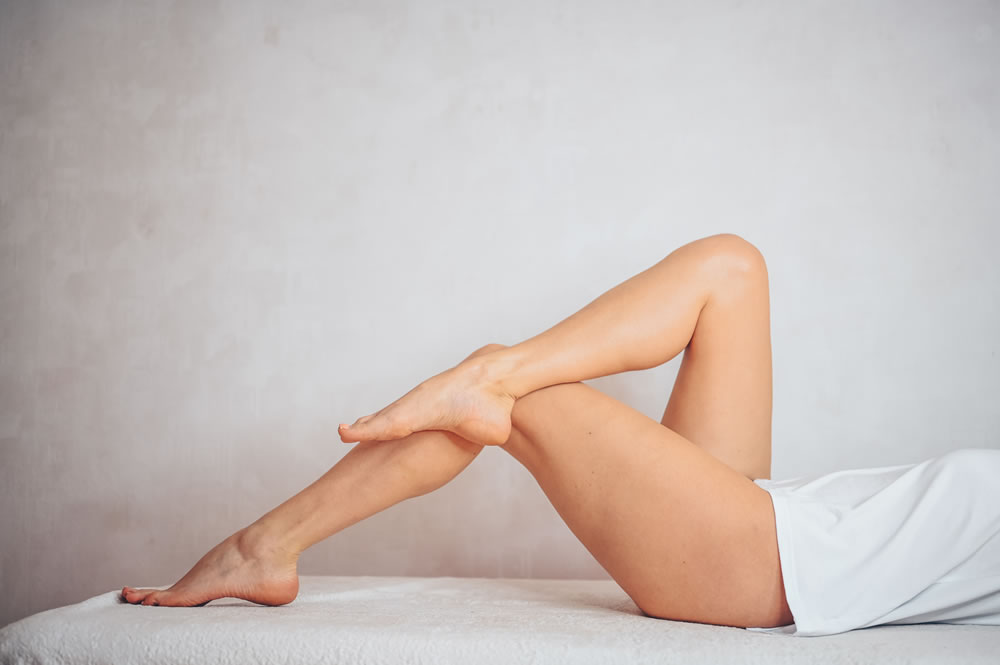
Is sclerotherapy permanent?
Sclerotherapy treats unwanted varicose and spider veins, removing them permanently. However, it can not prevent the formation of new spider or varicose veins in the lower extremities, which may develop due to age, genetics, or hormones. If new varicose or spider veins appear on your legs, you can undergo sclerotherapy treatment again. After sclerotherapy, the risk of developing new spider veins may be reduced by exercising regularly, maintaining a well-balanced diet, elevating your legs frequently, and changing your position often.
Can varicose veins be prevented?
While varicose veins cannot be entirely prevented, lifestyle changes can help reduce the risk of developing them. To achieve this, it is crucial to promote proper blood flow in your body by exercising regularly, consuming a high-fiber diet, wearing shoes without high heels, and ensuring that you adjust your position often to avoid sitting or standing in one place for too long. Regularly wearing compression stockings can help prevent new spider veins from forming by encouraging healthy blood circulation throughout the legs. Maintaining a healthy weight and losing weight if you are overweight is also advisable. While certain behaviors can aid in the prevention of spider and varicose veins, they can also be influenced by factors such as aging and genetics. Fortunately, there is a range of safe and effective treatment options available at expert dermatologist Dr. Green’s office in New York City. Dr. Green often combines sclerotherapy and laser therapy to reduce the unsightly appearance of varicose veins and alleviate any associated physical discomfort.
Can you fly after sclerotherapy?
No, you should not fly after No, you should not fly after sclerotherapy because the risk of developing a deep vein thrombosis or blood clot increases following sclerotherapy treatment (or other varicose/ spider vein treatments) when traveling on flights. It is not recommended to fly for at least several weeks after sclerotherapy treatment. Patients who have undergone sclerotherapy can fly a short distance (four hours or less) two weeks after their injections. Long-distance travel should be avoided until at least four weeks after treatment. This concern is even greater for patients who are taking oral contraceptives, smoking tobacco, using hormone therapy, or are generally in poor health. If you wish to treat leg veins and travel, please consult Dr. Green. Dr. Green will work with you to create a timeline for reducing your leg veins that ensures optimal results while keeping you safe and healthy, thereby limiting the risk of developing unwanted side effects.
Can you exercise after sclerotherapy?
Walking each day after Walking each day after sclerotherapy treatment is essential to reduce the risk of developing a blood clot and to promote optimal results. However, patients should refrain from strenuous exercise for at least 24 hours following the procedure. It is also important to remember to wear compression stockings for about two weeks after sclerotherapy treatment. Compression stockings should be worn throughout the day but can be removed at night. When you undergo your sclerotherapy treatment with Dr. Green at her private dermatology office in Manhattan’s Upper East Side neighborhood, she will provide all the relevant aftercare information necessary to ensure you achieve the best results.
Can you drive after sclerotherapy?
Yes, it is perfectly fine to drive a car after sclerotherapy injections.
Can I shower after sclerotherapy?
Many patients wonder, “When can I shower after sclerotherapy? It is okay to shower soon after having Sclerotherapy treatment. However, patients should avoid hot tubs, hot baths, and saunas for 48 hours after treatment to avoid increased swelling and redness at the injection sites.
When can I run after sclerotherapy?
Patients should refrain from running for 48 hours after sclerotherapy. While moderate exercising and light walking are encouraged after treatment, patients should avoid strenuous heavy exercise, including running.
Can you do sclerotherapy on the face?
While it is possible to perform sclerotherapy on the face, laser treatments like the VBeam are the preferred option for getting rid of spider veins and telangiectasias on the face. Most broken blood vessels on the face are superficial, allowing for the VBeam laser to treat them with no downtime or side effects. The VBeam laser uses pulsed dye technology to target and destroy broken blood vessels, causing them to collapse and become absorbed by the body. The laser treatment specifically targets red pigmentation on the skin, allowing the surrounding skin to be unaffected. Patients typically require a series of treatment sessions to see the best cosmetic results.
Is Varithena Sclerotherapy?
No, Varithena differs from injection sclerotherapy in that no sclerosant agent is used during treatment. Varithena is a microfoam option for treating varicose leg veins resulting from issues with the great saphenous vein. A small amount of microfoam is injected into the diseased vein, causing it to collapse. The most common side effects include bruising and tenderness at the injection sites. Compression stockings should be worn for two weeks following the treatment, and patients should avoid strenuous exercise for one week. Most patients require a single treatment session to achieve their ideal results, which typically lasts about an hour. Varithena is a prescription medication that should only be administered by a board-certified dermatologist. When you consult with Dr. Green at her private dermatology office in Manhattan’s Upper East Side neighborhood, she will physically assess your leg veins to determine which treatment option best suits your needs and goals.
What is sclerotherapy for hemorrhoids?
Sclerotherapy can be used to treat internal hemorrhoids that are classified as grade 1 or grade 2. These hemorrhoids do not prolapse and remain within the anal canal. During treatment, a sclerosing agent is injected into the tissue of the hemorrhoid, leading to its shrinkage and hardening. Sclerotherapy effectively reduces the appearance of internal hemorrhoids and alleviates symptoms such as bleeding or prolapse. Patients often require a series of sclerotherapy sessions for complete treatment of internal hemorrhoids. Regarding internal hemorrhoids, many patients inquire, “Can sclerotherapy be used for external hemorrhoids?” External hemorrhoids are located under the skin outside the anal canal. Healthcare professionals do not use sclerotherapy for treating external hemorrhoids; instead, they typically employ treatments such as rubber band ligation, infrared coagulation, or surgical removal. If you are experiencing hemorrhoids and are considering sclerotherapy, it is advisable to consult with a board-certified gastroenterologist or colorectal surgeon for appropriate treatment.
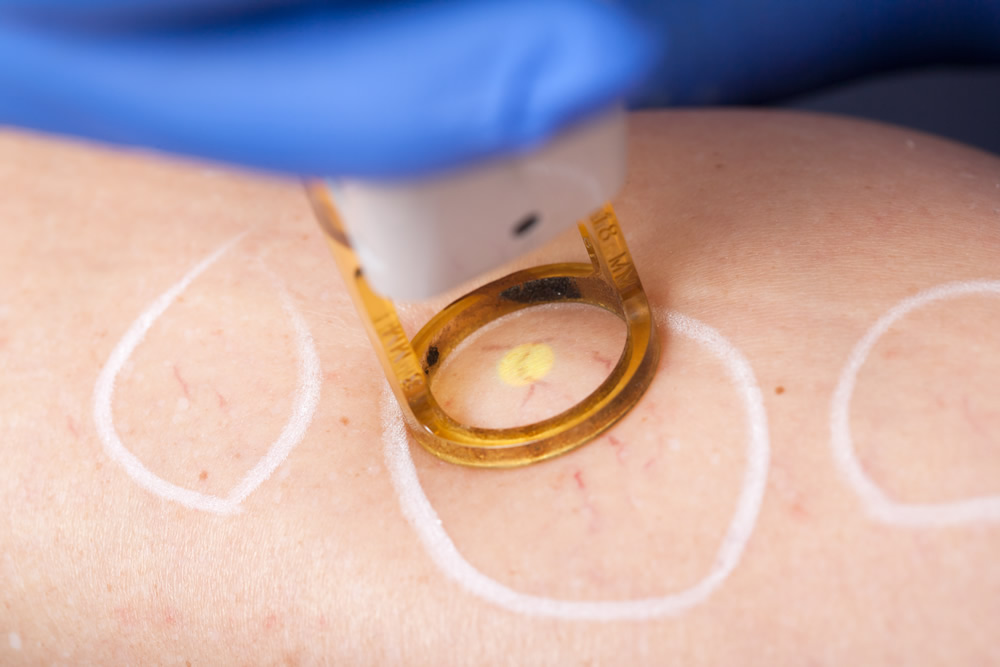
Is sclerotherapy worth it?
Yes! Most patients with unsightly varicose and Yes! Most patients with unsightly varicose and spider veins agree that sclerotherapy is worth it. Some clinical studies have shown that sclerotherapy can permanently eliminate 90% or more of the treated blood vessels. When sclerotherapy injections are performed by an expert, such as board-certified dermatologist Dr. Michele Green in NYC, the procedure is quick and well-tolerated, with few potential side effects. Most patients require several treatment sessions to achieve the final desired results, and although compression stockings must be worn for several weeks following each treatment session, the downtime is minimal. For many reasons, sclerotherapy is a popular cosmetic treatment for varicose and spider veins in the legs. It can help restore self-esteem and boost confidence in whatever you wear, which is always worth it!
How do I get started treating my spider veins and varicose veins today?
Sclerotherapy is a quick, minimally invasive treatment for eliminating the appearance of spider and varicose veins. Dealing with spider and varicose veins can be frustrating, especially if you have tried over-the-counter creams and lotions that claim to make them disappear but have had no success. Thankfully, non-invasive cosmetic treatment options like Sclerotherapy and V-Beam laser treatment are available to help those stubborn veins vanish. During the procedure, a sclerosing agent is injected into the damaged vessels, causing them to collapse, seal, and become invisible. Whether your spider veins have developed due to age or genetics, or if your job requires you to sit or stand for extended periods, Dr. Green is here to restore your confidence in your legs and help you wear your favorite summer dress again.
Dr. Michele Green is an internationally renowned board-certified Dr. Michele Green is a globally recognized, board-certified dermatologist with over twenty-five years of experience providing the best cosmetic treatment options to some of the world’s most discerning individuals, including sclerotherapy for leg veins. She is consistently recognized as one of NYC’s top dermatologists by Castle Connolly, New York Magazine, and Super Doctors, thanks to her commitment to her patients and her expertise. When you meet with Dr. Green at her private office in Manhattan’s Upper East Side office, she will work with you to create a personalized treatment plan that addresses your specific concerns. To schedule a consultation to find out if you are a good candidate for sclerotherapy, please call our NYC office today at 212 535 3088 or contact us online.
 212-535-3088
212-535-3088 